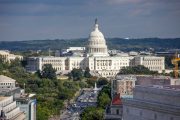
One Northern California county took another step toward secession from the rest of the state, while voters in another chose to get off that path.
With 56 percent of voters in favor of the proposal, Tehama County officials are now authorized to pursue the joining of the planned state of Jefferson. In Del Norte County, a similar measure was defeated, garnering only 41 percent of the vote.
In Del Norte County, an organization calling itself Keep It California campaigned to scuttle the secession measure. The group’s literature warned voters that if the proposal was approved, the county would suffer economic depression and children would suffer from the loss of federal school money. The group reportedly received its money from local labor unions.
In Siskiyou County, voters were asked Tuesday night whether they wanted to rename their county the Republic of Jefferson; it was rejected by 56 percent of voters.
“I’m going to definitely talk to the people of Jefferson and tell them to stick around,” Governor Jerry Brown said, as reported by the Sacramento Bee.
Although the measure mentions secession, the proposal itself does not instantly separate the approving counties from the rest of the Golden State. In fact, the resolution merely authorizes county officials to begin the process of investigating the possibility of proceeding toward secession.
Within the would-be independent republic, there are 16 counties with a total population of more than 450,000. The area makes up approximately one-fourth of California’s land mass. The state would be over twice the geographical size of New Hampshire.
California residents of the proposed state of Jefferson who support the breakaway point to onerous federal regulations and a “culture clash with urban areas.”
A story in Liberty Voice portrays the proposal as something reminiscent of American colonial complaints — complaints that led to our own secession from Great Britain.
Aaron Funk, a resident of Crescent City in Del Norte County, pointed out that the metropolitan area of Los Angeles has 20 state senators, and there are 10 who represent the San Francisco Bay Area. Meanwhile, one state senator is shared amongst 11 counties in Northern California. The residents of those counties do not feel that they have the representation they deserve.
Four counties in this rural region of California have previously signed off on the secession question: Glenn, Modoc, Siskiyou, and Yuba. County supervisors in Butte County have scheduled the vote for next week.
Setbacks notwithstanding, there are many proponents of the move that remain hopeful.
Mark Baird, a resident of Siskiyou County, reportedly said he is determined to continue the fight.
“There are people who are going to want this and there are people who won’t, but we aren’t ever going to quit until we get representation in rural Northern California,” he said, as quoted in the Sacramento Bee.
Regardless of the will of voters, however, any creation of a 51st state would require approval by the California state legislature and the federal Congress. Neither of those bodies is likely prepared to approve any such petition.
As for the state, it would suffer the loss of millions in tax revenue, likely prompting lawmakers to increase the burden on the remaining citizens of California.
With regard to the federal government, these counties simply want to become another state, not an independent republic, so the unconstitutional exercise of supreme power over the as-yet-fictitious state of Jefferson would seemingly carry on unabated, albeit with the bills for maintaining the massive federal bureaucracy being sent to a different address.
In a now classic comment on the subject of secession, Thomas DiLorenzo reminds readers that the Civil War-era confederacy was not the first attempt by Americans to secede from the federal government:
America’s second generation of secessionists were not the Southern Confederates but the New England Federalists who so loathed the idea of a Jefferson presidency that they plotted to secede for the next fourteen years. Their efforts culminated in the Hartford Secession Convention of 1814 (See James Banner, To the Hartford Convention: The Federalists and the Origins of Party Politics in Massachusetts). Much of the discussion of the New England secessionists is contained in Henry Adams, editor, Documents Relating to New-England Federalism. In it one learns that the leader of the New England Yankee secessionists was United States Senator Timothy Pickering, who had previously served as George Washington’s adjutant general and quartermaster during the Revolution, and later as secretary of state and secretary or war in the Washington administration.
In 1803 Pickering announced that with New England seceding from the union “I will rather anticipate a new confederacy, exempt from the corrupt and corrupting influence of the aristocratic Democrats of the South.” United States Senator James Hillhouse agreed that “The Eastern States must and will dissolve the union and form a separate government.” George Cabot, Elbridge Gerry, John Quincy Adams, Fisher Ames, Josiah Quincy, and Joseph Story, among others, voiced similar opinions in the first years of the nineteenth century.
Governor Roger Griswold of Connecticut proclaimed that because of the political clout of the Southern states, “there can be no safety [from political plunder] to the Northern States without a separation from the confederacy [a.k.a. the union].” Senator Pickering explained that secession was THE principle of the American Revolution when he said that “the principles of our Revolution point to the remedy — a separation. [Emphasis in original.] That this can be accomplished, and without spilling one drop of blood, I have little doubt.” And he was right: President Jefferson considered New Englanders to be an integral part of the American family, and the last thing in the world he would have done was to launch an invasion of New England, bombing Boston, Providence, and Hartford and turning them into a smoldering ruin to “save the union.”
The New England Federalists eventually decided in 1814 at the Hartford Secession Convention to remain in the union and work within the system. All during this fourteen year ordeal the predominant view of the New England Federalists as well as the Jeffersonian Democrats was that of course the American union was voluntary, and of course the states therefore have a right to secede without asking for or being given permission by anyone or by any other government.
As was written in a Wisconsin newspaper in 1861, “”Secession is the very germ of liberty … the right of secession inheres to the people of every sovereign state.”
Despite the frequent violations of the terms of the terms of the contract (Constitution) by the federal government, states and people are not left with the only option of voiding the contract and seceding from the union. In fact, those state lawmakers and governors committed to forcing the federal beast back into its constitutional cage are better served by simply nullifying each and every congressional act or presidential decree that violates the agreed-upon terms in the Constitution.
There are several benefits of this attitude: It preserves the union, and demonstrates state allegiance to the principles of freedom that undergird the Constitution, and by extension, to our Founders.
Nullification is also preferable because it is a less radical reaction than secession. It is a flexible and potent weapon in the war against unconstitutional federal acts (acts that exceed the enumerated powers) that solves the sovereignty issue without dissolving the union.
That isn’t to say, however, that secession should be taken off the table. No sovereign entity can by definition by compelled to continue association with any league, confederacy, or union that goes from being advantageous to despotic.
If states decided that the federal authority has become destructive of the very ends it was created to protect, then it is the right of that state or states to — as someone once said of another formerly free government — “dissolve the political bands which have connected them with another, and to assume among the powers of the earth, the separate and equal station to which the Laws of Nature and of Nature’s God entitle them.”
The laws of nature are immutable and cannot be altered simply by one party’s assumption of power which does not legally appertain to it. It was so in 1776 and it is so now. Might does not make right.
The federal government may be stronger, richer, better armed, and possessed of monopolistic control of the press that prints all the money, but it nevertheless has no right and no authority to impose its will on the states and the people, particularly when that will is set on aggrandizing itself to the detriment of those that gave it life.
Regarding the movement toward secession in California, however, the state of Jefferson, if it ever exists, will be just another source of legal plunder for a federal authority that has broken all restraints on its power.
Joe A. Wolverton, II, J.D. is a correspondent for The New American and travels nationwide speaking on nullification, the Second Amendment, the surveillance state, and other constitutional issues. Follow him on Twitter @TNAJoeWolverton and he can be reached at [email protected].

